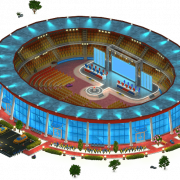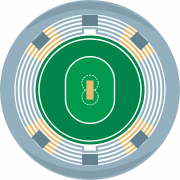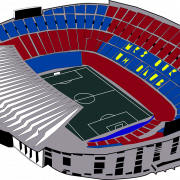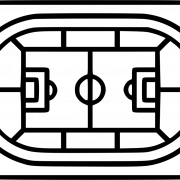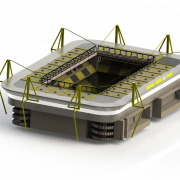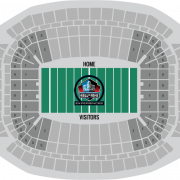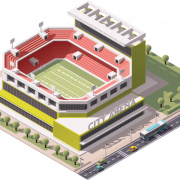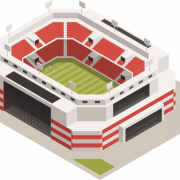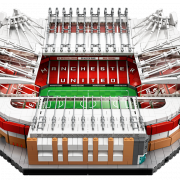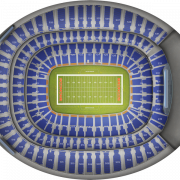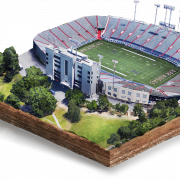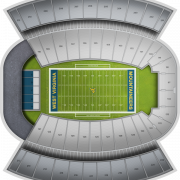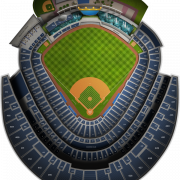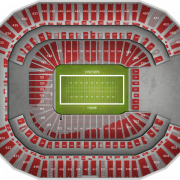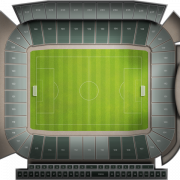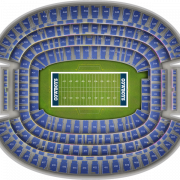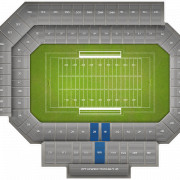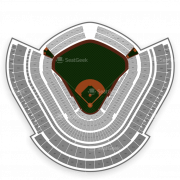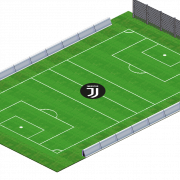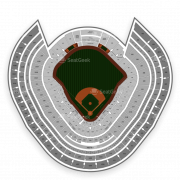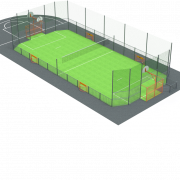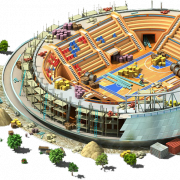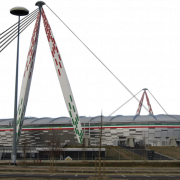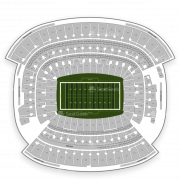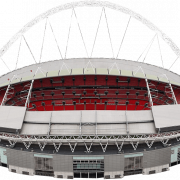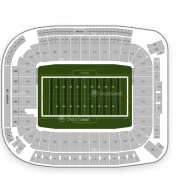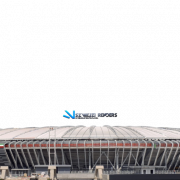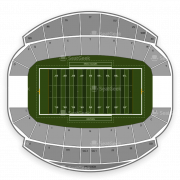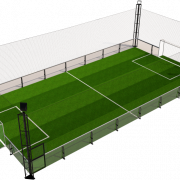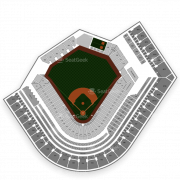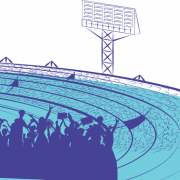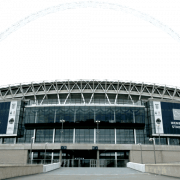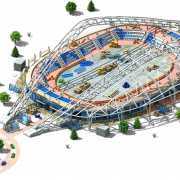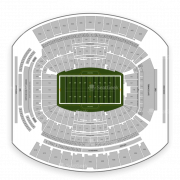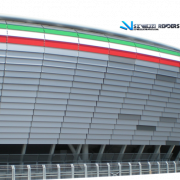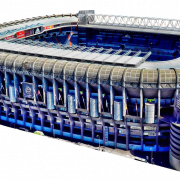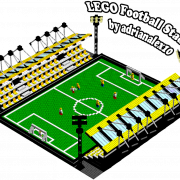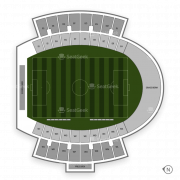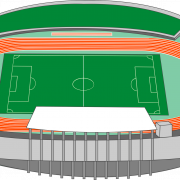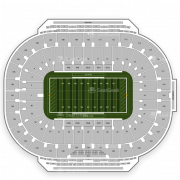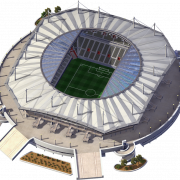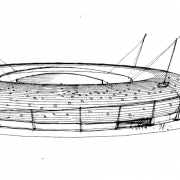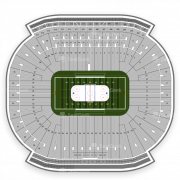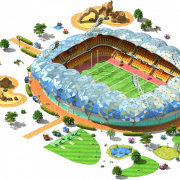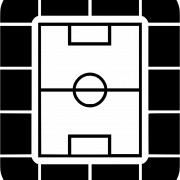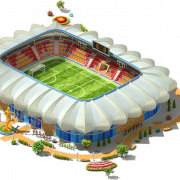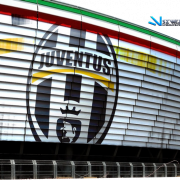Download top and best high-quality free Stadium PNG Transparent Images backgrounds available in various sizes. To view the full PNG size resolution click on any of the below image thumbnail.
License Info: Creative Commons 4.0 BY-NC
A stadium (plural stadiums or stadia) is a venue for (mainly) outdoor sports, concerts, or other events that consists of a field or stage surrounded by a tiered structure that allows people to stand or sit and watch the action.
The race that covered one length of the stadion at Olympia, whence the name “stadium” originates, was the only event during the ancient Greek Olympic celebration for almost half a century, according to Pausanias.
Association football is played in most venues with a capacity of at least 10,000 people. Gridiron football, baseball, cricket, the different codes of rugby, field lacrosse, bandy, and bullfighting are all popular stadium sports. Concerts are held in many big sporting arenas.
“Stadium” is the Latinized version of the Greek word “stadion” (v), a unit of length equal to 600 human feet. Because feet vary in length, the length of a stadion is determined by the specific length selected for one foot at a given location and time. Although one stadion equals 600 feet (180 meters) in contemporary terms, it can refer to a length of up to 15% larger or smaller in ancient contexts.
The corresponding Roman measure, the stadium, was roughly 185 m (607 ft) long, but instead of being measured in feet, it was measured in passus, which was a distance of 125 passus (double-paces).
The English word stadium derives from the tiered architecture that surrounds a long Roman track.
Both stadiums and stadia are accepted as acceptable English plurals in most dictionaries.
The Stadium at Olympia in Greece, where the ancient Olympic Games were held from 776 BC, is the earliest known stadium. Initially, the Games consisted of only one event: a sprint over the stadium’s length.
Numerous Greek and Roman stadiums have been discovered in ancient towns, the most renowned of which being the Domitian Stadium in Rome.
Before hosting the first modern Olympics in 1896, the 1906 Intercalated Games, and certain events of the 2004 Summer Olympics, the unearthed and renovated old Panathenaic Stadium held attempted revivals of the Olympic Games in 1870 and 1875. The stadium was excavated and restored as part of the Greek national benefactor Evangelos Zappas’ legacy, and it was the first ancient stadium to be utilized in contemporary times.
The first stadiums created in the modern period were simple structures with the sole goal of accommodating as many spectators as possible. The earliest such buildings were erected in response to the enormous rise in popularity of the organized sport in the late Victorian era, particularly association football in the United Kingdom and baseball in the United States. The Lansdowne Road Stadium, designed by Henry Dunlop, who organized the inaugural All Ireland Athletics Championships, was one of these early stadiums. Dunlop erected the stadium in 1872 after being barred from holding athletic events at Trinity College. “With my own theodolite, I put out a quarter-mile cinder running path, laid down the present Lansdowne Tennis Club pitch, created a Lansdowne archery club, a Lansdowne cricket club, and, last but not least, the Lansdowne Rugby Football Club — colors red, black, and yellow.” Dunlop was able to use his technical abilities to construct a pitch coveted across Ireland by using 300 cartloads of Earth from a ditch beneath the railway to elevate the ground.
Download Stadium PNG images transparent gallery.
- Vector Stadium PNG Photo
Resolution: 829 × 489
Size: 140 KB
Image Format: .png
Download
- Vector Stadium PNG Image HD
Resolution: 1024 × 1024
Size: 56 KB
Image Format: .png
Download
- Stadium PNG Clipart
Resolution: 800 × 800
Size: 100 KB
Image Format: .png
Download
- Vector Stadium PNG
Resolution: 3109 × 2285
Size: 588 KB
Image Format: .png
Download
- Vector Stadium PNG Image
Resolution: 3109 × 2285
Size: 528 KB
Image Format: .png
Download
- Football Stadium PNG Free Download
Resolution: 1280 × 748
Size: 653 KB
Image Format: .png
Download
- Sports Stadium PNG HD Image
Resolution: 2000 × 1308
Size: 69 KB
Image Format: .png
Download
- Vector Stadium Transparent
Resolution: 2048 × 1540
Size: 1226 KB
Image Format: .png
Download
- Stadium PNG Free Download
Resolution: 1417 × 1417
Size: 41 KB
Image Format: .png
Download
- Football Stadium PNG Picture
Resolution: 981 × 716
Size: 40 KB
Image Format: .png
Download
- Vector Stadium PNG Clipart
Resolution: 2048 × 2047
Size: 1285 KB
Image Format: .png
Download
- Stadium PNG Picture
Resolution: 980 × 548
Size: 16 KB
Image Format: .png
Download
- Stadium PNG Free Image
Resolution: 800 × 800
Size: 18 KB
Image Format: .png
Download
- Sports Stadium PNG Pic
Resolution: 702 × 486
Size: 59 KB
Image Format: .png
Download
- Stadium PNG File
Resolution: 853 × 640
Size: 523 KB
Image Format: .png
Download
- Vector Stadium PNG Free Download
Resolution: 1200 × 990
Size: 124 KB
Image Format: .png
Download
- Vector Stadium PNG Picture
Resolution: 1024 × 1024
Size: 106 KB
Image Format: .png
Download
- Stadium PNG HD Image
Resolution: 773 × 619
Size: 94 KB
Image Format: .png
Download
- Vector Stadium PNG Free Image
Resolution: 804 × 517
Size: 170 KB
Image Format: .png
Download
- Vector Stadium PNG File
Resolution: 1024 × 680
Size: 61 KB
Image Format: .png
Download
- Stadium PNG Image
Resolution: 1024 × 576
Size: 858 KB
Image Format: .png
Download
- Football Stadium PNG High Quality Image
Resolution: 763 × 600
Size: 989 KB
Image Format: .png
Download
- Football Stadium PNG Images
Resolution: 1024 × 483
Size: 1111 KB
Image Format: .png
Download
- Stadium PNG Pic
Resolution: 1024 × 572
Size: 1015 KB
Image Format: .png
Download
- Football Stadium PNG Download Image
Resolution: 600 × 665
Size: 621 KB
Image Format: .png
Download
- Football Stadium PNG Pic
Resolution: 600 × 703
Size: 858 KB
Image Format: .png
Download
- Football Stadium PNG HD Image
Resolution: 698 × 600
Size: 848 KB
Image Format: .png
Download
- Stadium
Resolution: 1024 × 485
Size: 1347 KB
Image Format: .png
Download
- Football Stadium PNG Free Image
Resolution: 788 × 600
Size: 887 KB
Image Format: .png
Download
- Football Stadium PNG File
Resolution: 668 × 600
Size: 922 KB
Image Format: .png
Download
- Football Stadium
Resolution: 693 × 600
Size: 778 KB
Image Format: .png
Download
- Sports Stadium
Resolution: 1024 × 549
Size: 815 KB
Image Format: .png
Download
- Sports Stadium PNG Download Image
Resolution: 1025 × 953
Size: 496 KB
Image Format: .png
Download
- Stadium PNG Download Image
Resolution: 1757 × 964
Size: 739 KB
Image Format: .png
Download
- Sports Stadium PNG High Quality Image
Resolution: 1001 × 952
Size: 447 KB
Image Format: .png
Download
- Sports Stadium PNG Images
Resolution: 1001 × 816
Size: 720 KB
Image Format: .png
Download
- Sports Stadium PNG Image File
Resolution: 953 × 410
Size: 665 KB
Image Format: .png
Download
- Sports Stadium PNG Photo
Resolution: 1024 × 546
Size: 560 KB
Image Format: .png
Download
- Football Stadium PNG Image File
Resolution: 1025 × 977
Size: 440 KB
Image Format: .png
Download
- Stadium PNG High Quality Image
Resolution: 1000 × 600
Size: 882 KB
Image Format: .png
Download
- Vector Stadium
Resolution: 800 × 520
Size: 155 KB
Image Format: .png
Download
- Sports Stadium PNG Image HD
Resolution: 1001 × 934
Size: 251 KB
Image Format: .png
Download
- Sports Stadium PNG File Download Free
Resolution: 1009 × 425
Size: 356 KB
Image Format: .png
Download
- Sports Stadium PNG Transparent HD Photo
Resolution: 1001 × 984
Size: 304 KB
Image Format: .png
Download
- Stadium PNG Images
Resolution: 817 × 539
Size: 573 KB
Image Format: .png
Download
- Sports Stadium PNG
Resolution: 1601 × 540
Size: 471 KB
Image Format: .png
Download
- Vector Stadium PNG HD Image
Resolution: 1024 × 1024
Size: 91 KB
Image Format: .png
Download
- Sports Stadium PNG Image
Resolution: 1025 × 956
Size: 463 KB
Image Format: .png
Download
- Stadium Light
Resolution: 2742 × 1384
Size: 1839 KB
Image Format: .png
Download
- Vector Stadium PNG Pic
Resolution: 1111 × 527
Size: 290 KB
Image Format: .png
Download
- Stadium PNG Image File
Resolution: 1109 × 510
Size: 109 KB
Image Format: .png
Download
- Vector Stadium PNG Download Image
Resolution: 1150 × 563
Size: 819 KB
Image Format: .png
Download
- Football Stadium PNG
Resolution: 1025 × 997
Size: 392 KB
Image Format: .png
Download
- Stadium PNG Photo
Resolution: 1024 × 505
Size: 641 KB
Image Format: .png
Download
- Stadium Light PNG
Resolution: 995 × 1742
Size: 103 KB
Image Format: .png
Download
- Stadium Light PNG Image
Resolution: 715 × 536
Size: 426 KB
Image Format: .png
Download
- Sports Stadium Transparent
Resolution: 1000 × 557
Size: 223 KB
Image Format: .png
Download
- Stadium PNG Image HD
Resolution: 1024 × 514
Size: 1295 KB
Image Format: .png
Download
- Football Stadium PNG Image
Resolution: 830 × 904
Size: 69 KB
Image Format: .png
Download
- Sports Stadium PNG Clipart
Resolution: 1025 × 822
Size: 662 KB
Image Format: .png
Download
- Sports Stadium PNG Free Download
Resolution: 1025 × 1010
Size: 261 KB
Image Format: .png
Download
- Stadium PNG File Download Free
Resolution: 1920 × 994
Size: 195 KB
Image Format: .png
Download
- Sports Stadium PNG Picture
Resolution: 1025 × 968
Size: 303 KB
Image Format: .png
Download
- Vector Stadium PNG High Quality Image
Resolution: 1000 × 791
Size: 1048 KB
Image Format: .png
Download
- Sports Stadium PNG Free Image
Resolution: 950 × 455
Size: 89 KB
Image Format: .png
Download
- Football Stadium Transparent
Resolution: 1001 × 967
Size: 369 KB
Image Format: .png
Download
- Sports Stadium PNG File
Resolution: 1104 × 615
Size: 377 KB
Image Format: .png
Download
- Stadium PNG
Resolution: 844 × 980
Size: 15 KB
Image Format: .png
Download
- Vector Stadium PNG Images
Resolution: 910 × 508
Size: 119 KB
Image Format: .png
Download
- Vector Stadium PNG Image File
Resolution: 900 × 904
Size: 148 KB
Image Format: .png
Download
- Football Stadium PNG Clipart
Resolution: 961 × 961
Size: 84 KB
Image Format: .png
Download
- Stadium Transparent
Resolution: 1024 × 534
Size: 1272 KB
Image Format: .png
Download
